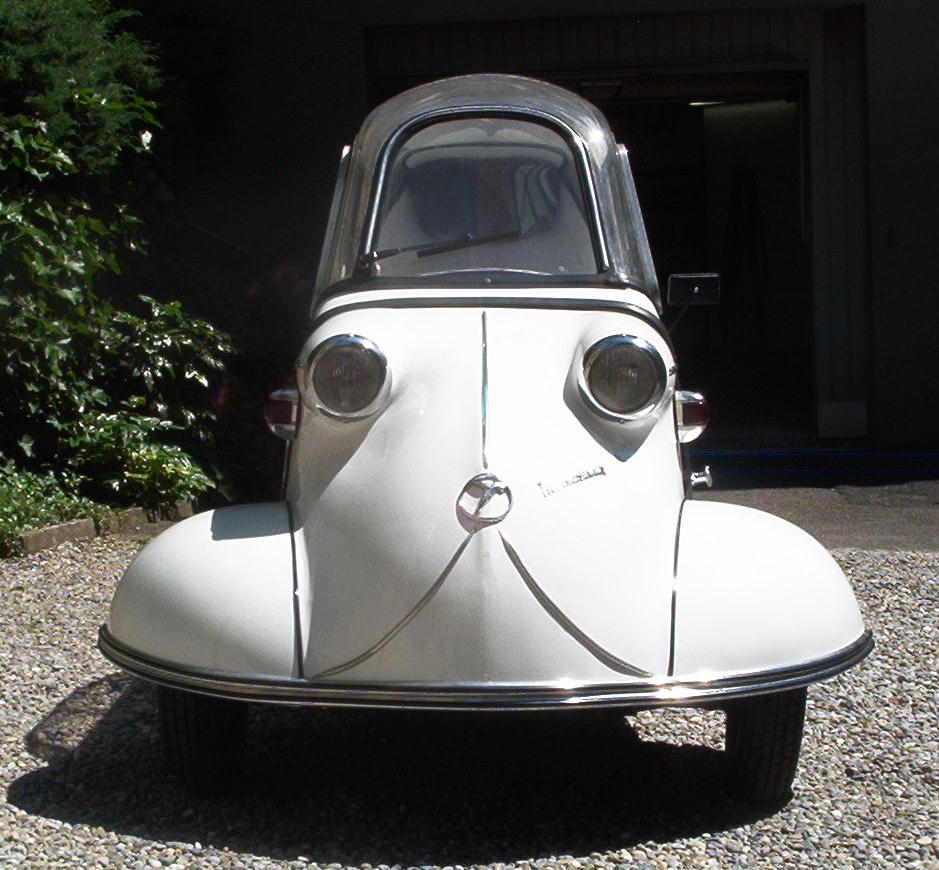
Of the many nations to which the Messerschmitt Kabinenroller was exported its greatest success and warmest welcome was in Great Britain. Londoners saw the export model KR 175 on their streets for the very first time in April 1954. A new trend had begun and in time the amazing little car from Regensburg had established itself as a fashionable sight in our great capital city. But it was not merely the novel configuration of the Kabinenroller that aroused interest. The car was new but the emblem on its nose needed no Introduction.
31st August 1954: Seen in London this afternoon was this novel two seater in tandem three-wheeled enclosed motor cycle – which is made by the R.S.M. Messerschmitt Company of Germany. It does 50mph and 120 miles to the gallon, and costs approximately £300
In 1954 you could have asked, anyone in Britain “what is a Messerschmitt ?” and got the reply, “the aeroplane that gave us a lot of trouble in 1940″. That name, the inscription “Made in Germany”, and the world famous Sachs motor was a guarantee of quality. Even today, more than sixty years later, there are people in Britain who still believe the Kabinenroller was the product of the fertile imagination of the aircraft designer Professor Willy Messerschmitt. But in August1955 the arrival of the first vastly improved model KR 200 in Britain and the astonishing news of the achievement by the KR 200 Super of 25 world records at Hockenheim racetrack, revealed the true identity of the ‘father of the KaRo’. Because the Kabinenroller is an entirely original concept and not merely a development of some other vehicle, any consideration of its history takes place within the context of the life and work of its creator, Ing. (formal German title for professional Engineer) Fritz Fend. Fend was at the summit of his powers in the 1980’s and was still developing new ideas as an innovative and versatile designer in the great tradition of Messerschmitt and Porsche. He can be compared, from the British perspective, to Issigonis or Chapman whose work reflects credit not only on himself but also on his adopted city of Regensburg . He is of the generation which in 1945 faced the task of reconstruction in the Federal Republic of Germany with outstandingly successful results which today are admired throughout the world.
Those who lived through the years 1939-1945 never recall them with any pleasure. But, in retrospect we can identify some developments which were e accelerated in those years with subsequent benefit to mankind. The evolution of jet powered flight is one example and it was Fritz Fend’s intensive development work as a young engineer on the ME262 programme which formed the foundation of mutual respect and confidence between Professor Maessrschmitt and himself which eventually led to the introduction of the KR 175 in March 1953.
To continue after 1945 as an aeronautical engineer as he wished , meant emigration – Fritz Fend rejected this option and instead chose to devote his skills to the rehabilitation of the severely war wounded, particularly those with both legs amputated above the knee, by designing special vehicles and individually adapted Kabinenrollers. British war wounded often found the adapted Kabinenroller an ideal solution to their personal transport problems.
The decision in 1952 of the former Regensburger Stahl und Metalbau Company to produce the Fend Lastenroller, and then the Kabinenroller, created many employment places and is remembered as a major contribution to the city’s post war economic development for which credit is due to Professor Messerschmitt and Fend. Production faltered in 1956, and Herr Fend , in association with Herr Ing. Valentin Knott, did not hesitate to seize the initiative in forming the Fahrzeug und Maschinenbau Regensburg Company in January 1957 thereby securing the future, not only of the Kabinenroller but also all of his employees for many more years. With the arrival in Britain of more and more KaRos the Messerschmitt Owners Club was formed in London in November 1956 and still flourishes with more than 550 members – a tribute to more than 60 years of sustained effort by the Club management. Today our Club is extremely proud of the friendly relationship long established members of Messerschmitt Club Deutschland e.V. with whom we actively co-operate in the sourcing of spare parts to keep Messerschmitts on the road in more than 20 different countries spread over 5 continents. Outside of Europe, the USA was a significant export market and today the Messerschmitt receives wide acclaim in collector’s car circles.
The launch, in May 1958 of the incredible model Tg 500 captured the imagination of Messerschmitt fans in Britain. Impatient for its arrival and when, four months later, it arrived, Messerschmitt fans we were not disappointed. Our Club welcomed Herr and Frau Fend for the first time for the official British launch of the Tiger on 29 September that year at Brands Hatch Circuit In a typical gesture by Ing.Fend while he was in England, and when learning of a Club event in the midlands voluntarily drove 200miles further north to give an unofficial demonstration one day before this amazing sports car was shown to the press and public. Today, the Tg500 is considered to be among the most desirable of the world’s collectors’ cars and its rarity and sporting achievements keep prices astonishingly high.
Phil Boothroyd with editing and additional information by David Garner
